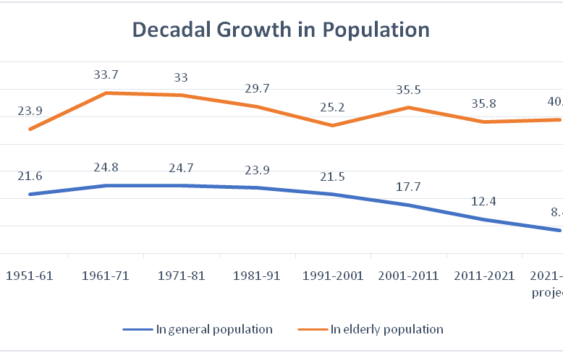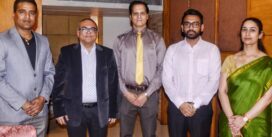- एचडीएफसी बैंक ने उज्जैन “व्यापार मेला 2025” में ऑटो लोन पर विशेष ऑफर्स पेश किए
- रियलिटी शोज़ का नया दौर! अब और भी ज्यादा ड्रामा और रोमांच, सिर्फ जियोहॉटस्टार पर
- फेलिसिटी थिएटर इंदौर में "हमारे राम" प्रस्तुत करता है
- जेएसडब्ल्यू ग्रुप के चेयरमैन सज्जन जिंदल को एआईएमए मैनेजिंग इंडिया अवार्ड्स में मिला 'बिजनेस लीडर ऑफ डिकेड' का पुरस्कार
- उर्वशी रौतेला 12.25 करोड़ रुपये में रोल्स-रॉयस कलिनन ब्लैक बैज खरीदने वाली पहली आउटसाइडर इंडियन एक्ट्रेस बन गई हैं।
Population Ageing and Economic Dependency High Among Females in India

By: Dr. Vilasini Devi Nair, Health Economist, Goa Institute of Management (GIM), and Dr. P Balasubramanyam, Data Analyst, Goa Institute of Management (GIM)
An aging population is an inevitable demographic phenomenon associated with improvements in health and health care systems and economic well-being. Declining fertility, lower infant mortality, and increased survival at older ages are the primary demographic factors that contribute to population aging – all of which are markers of success and development. The decrease in communicable diseases and improved control of chronic non-communicable diseases have a favorable impact. Since 1961, there has been an upward trend in the share of elderly people in India’s total population. The elderly population grew by 36% in the last two decades (2001-2011 and 2011-2021) and is projected to be 40.5% in 2031. figure 1

Source ‘Elderly in India 2021’ NSO India
In 1961, 5.6% of the population was in the age category of 60 years or more, the proportion has increased to 10.1% in 2021 and is projected to increase to 13.1% in 2031. A similar trend has also been observed in rural as well as in urban areas. In rural areas, the proportion of elderly persons has risen from 5.8% in 1961 to 8.8% in 2011, whereas in urban areas it has increased from 4.7% to 8.1% during 1961 to 2011. It also is worth noting that the percentage (of elderly) has always been higher in rural areas than in metropolitan areas, and that it is usually higher among females than males.
Among 21 major states, Kerala has the maximum proportion of elderly people (16.5%) followed by Tamil Nadu (13.6%), Himachal Pradesh (13.1%), Punjab (12.6%), and Andhra Pradesh (12.4%) in 2021. On the contrary, the proportion is the least in the States of Bihar (7.7%) followed by Uttar Pradesh (8.1%) and Assam (8.2%).
Despite the fact that population aging is a good indicator, almost all countries are confronted with two major challenges as a result of this phenomenon: (i) aging of the population, which has resulted in a large increase in the population aged 80 and above, and (ii) feminization of aging, which has seen women live longer than men. Both of these aspects are contributing to an increase in the elderly’s economic dependency.
In India, people between the ages of 15 and 59 are considered to be working-age, whereas those above the age of 60 are expected to retire or withdraw from work. Since 1961, India has likewise seen an uptick in old-age dependency. From 10.9% in 1961, the ratio is expected to rise to 15.7% and 20.1% in 2021 and 2031, respectively. As the research indicates, there are significant disparities between urban and rural areas, as well as between men and women.
According to the (National Sample Survey)NSS 75th Round, nearly 70% of the elderly had to rely on others for day-to-day maintenance. In India, only 10% of rural women and 11% of urban women were economically self-sufficient, compared to 48% and 75% for males. In addition, the dependency ratio of males and females has been steadily growing over time. In males, it rose from 10.9% in 1961 to 14.8% in 2021, and in females, it increased from 10.9% to 16.7% during the 1961- 2021 period. However, over these periods, there are notable variations observed in the old-age dependency ratio in rural and urban areas. It increased from 11.4 to 15.7 in rural areas and 8.7%to 13.7% in urban areas. This may be due to the relatively higher concentration of literate and working-age population in urban areas. figure 1
Figure2 Old age dependency in India

Source from NSSO 75th round
States wise disparities in economic dependency were also discovered in the surveys. Among the major states, the overall old-age dependency ratio varied over time from state to state. It was 10.4% in Delhi to 19.6% in Kerala in 2011. However, the projected figures for the year 2021, vary from 12.7% in Assam to 26.1% in Kerala, and for the year 2031, the old-age dependency ratio is projected to vary from 15.6% in Bihar to 34.3% in Kerala.
The female old-age dependency ratio as compared to males is significantly high in states like Kerala (27.8% vs 24.3%), Tamil Nadu (21.3%vs 19.3%), Himachal Pradesh (21.2%vs 18.1%), and Punjab (20.1% vs 17.7%) for the projected the year 2021.
The proportion of elderly males who are fully dependent on others is highest in Assam (42%) and lowest in Nagaland (4%). Whereas, in females, the figure is highest in Delhi (100%) and lowest in Manipur (24%). The data reveals that in rural areas, the proportion of elderly females who are fully dependent on their spouse is highest in Jammu & Kashmir (40%) followed by Haryana (35%), Mizoram (34%), and is lowest in Assam (4%) followed by 8% in Delhi, Goa, and Manipur.
In India, the majority of the population is aged less than 30, and the problems and issues of old age economic dependency have not been given much consideration. Elderly people in India are more likely to be exposed to physical, social, and financial insecurity as a result of rapid changes in the socio-economic landscape, labour-related migration, and the growing predominance of nuclear family structures. As women live longer (than men), they may experience chronic health problems, physical disabilities, high levels of economic dependency, and gender-based discrimination and violence. Income insecurity is a significant aspect of vulnerability among older women. About 59% of older females don’t have any permanent income or pension. In conclusion: India urgently needs to address the socio-economic and health-related concerns of the elderly, with a special focus on elderly females in a comprehensive way.
(The article is written by Dr. Vilasini Devi Nair, Assistant Professor, and Dr. P Balasubramanyam, Associate Professor from leading B-school Goa Institute of Management (GIM), and draws reference to the report ‘Elderly In India 2021’, by NSO India)


